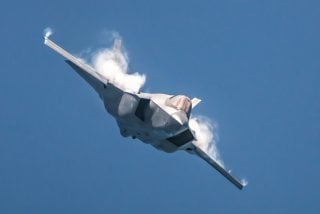Lockheed's LMXT Tanker Could Expand Combat Options in the Pacific
Lockheed Martin is offering its LMXT as a potential solution for upgrading the Air Force’s KC-Y program, which is the second phase of a large-scale plan to upgrade the Air Force’s tanker fleet using commercially derived aerial refueling aircraft.
The Air Force’s fast-emerging KC-Y Bridge Tanker program seems intended to meet a pressing short-term need for available tankers to deploy in coming years while sufficient numbers of the KC-46 Pegasus tanker aircraft continue to arrive. Yet there may be another interesting dynamic to this equation beyond purely tanking, given the Air Force’s heavy emphasis upon multi-domain networking and air-land-sea integrated operations.
How might an effective commercially derived tanker aircraft, intended to replace the aging KC-135 Stratotanker, fit into the Air Force’s Joint All Domain Command and Control (JADC2) program? Could the easily upgradable aircraft be engineered so that it can conduct multiple missions using its sensing and command and control systems sufficient to plug into an expansive combat network?
Lockheed Martin is offering its LMXT as a potential solution for upgrading the Air Force’s KC-Y program, which is the second phase of a large-scale plan to upgrade the Air Force’s tanker fleet using commercially derived aerial refueling aircraft. The LMXT is a militarized variant of the Airbus A330 MRTT multirole tanker aircraft. Lockheed Martin’s developers have noted that the aircraft is already in service with thirteen key U.S. allies. It has a boom/drogue refueling system, fly-by-wire automatic boom/air-to-air refueling systems and advanced sensor cameras. Developers say it can offload as much as 60 percent more fuel than a KC-46A Pegasus and grows that gap to 150 percent at three thousand nautical miles.
In addition to these advantages, the LMXT could be engineered to plug into JADC2 and function as a command-and-control system within a larger meshed network of interconnected platforms. Lockheed Martin’s statements on the LMXT seem to imply it is building an airplane with the capability to conduct multiple missions; a company statement describes the LMXT as “a multi-domain operations node that connects the LMXT to the larger battlespace, increasing onboard situational awareness to provide resilient communications and datalinks for assets across the force.”
Lockheed Martin has described the tanker aircraft’s datalinks, multi-domain operations and onboard situational awareness in a manner that seems to further support the scope of the KC-Y program, which aims to take on additional tactical functionality within a broader multi-service “information warfare” and “sensor-to-shooter” strategy. The program will achieve this goal by linking airborne fighters with armored vehicles and even surface ships as part of a coordinated combat system. In this respect, the LMXT could support and refuel carrier-launched F-35C jets as well as land-based fixed-wing assets needing to expand mission scope across vast areas of operation.
It makes sense to build the LMXT for multi-mission sensing, data transmission and reconnaissance missions. The KC-135 Stratotanker was used for these functions, too, to a certain extent. Further, a Defense Department report published in 2020 says that tankers can provide critical support to short-take-off-and-landing aircraft needing to take off with less fuel due to the absence of a runway.
In order to function with great effectiveness in the Pacific region, the LMXT would need sufficient basing options and to be safeguarded from China’s known arsenal of short-, medium- and long-range ballistic missiles. Given that the LMXT would need “land basing” throughout the theater, there are some interesting ways in which protective strategies can be employed, according to a research paper published by Air University at the Air Force Research Institute. The paper, titled Basing Strategies in Air Refueling Forces in Anti-Access/Area-Denial Environments, specifically takes up the issue of pursuing offensive operations against China in the Pacific region.
“US operations can impose great uncertainty on enemy command systems by degrading the fidelity and velocity of their ISR and command, control, and communications systems and by protecting forces through sheltering, deceptive basing, and/or maneuvering them faster than they can be tracked,” according to the research paper. “These actions would increase and exploit the inescapable reluctance of enemy commanders to take shots at uncertain targets with weapons that are in short supply and that must be husbanded in consideration of broader strategic concerns.”
Should LMXTs be properly based, sheltered and shielded, and perhaps even escorted by armed fighter jets, then they could operate in vast ocean areas throughout the region. It might also be possible to arm an LMXT with air-dropped bombs or even cruise missiles or air-to-air munitions. The Air Force is already testing air-launchers built into cargo aircraft carrying palletized weapons racks for potential aerial attack. Senior Air Force officials have said that it only makes sense to broaden the combat functionality of these kinds of aircraft given that they are already enemy targets. Should a tanker aircraft drop bombs, deliver cargo or ammunition, or conduct sensor-driven aerial reconnaissance as part of a mission, then other fixed-wing aircraft might not need to fly. This scenario would reduce operational risk.
Kris Osborn is the defense editor for the National Interest. Osborn previously served at the Pentagon as a Highly Qualified Expert with the Office of the Assistant Secretary of the Army—Acquisition, Logistics & Technology. Osborn has also worked as an anchor and on-air military specialist at national TV networks. He has appeared as a guest military expert on Fox News, MSNBC, The Military Channel, and The History Channel. He also has a Master's Degree in Comparative Literature from Columbia University.

